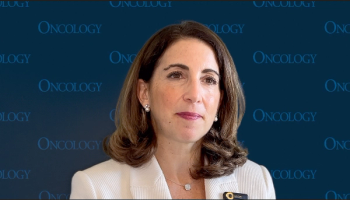
- Oncology NEWS International Vol 11 No 2
- Volume 11
- Issue 2
Tamoxifen Prevents Benign Breast Lesions in High-Risk Women
SAN ANTONIO-Tamoxifen (Nolvadex) therapy not only prevents breast cancer but also benign breast disease in high-risk women, according to a study by the National Surgical Adjuvant Breast and Bowel Project (NSABP) presented at the 24th San Antonio Breast Cancer Symposium (abstract 7). Elizabeth Tan-Chiu, MD, of the NSABP, reported the findings.
SAN ANTONIOTamoxifen (Nolvadex) therapy not only prevents breast cancer but also benign breast disease in high-risk women, according to a study by the National Surgical Adjuvant Breast and Bowel Project (NSABP) presented at the 24th San Antonio Breast Cancer Symposium (abstract 7). Elizabeth Tan-Chiu, MD, of the NSABP, reported the findings.
In 1998, she said, the NSABP P-I trial established that tamoxifen reduces the incidence of invasive breast cancer (NSABP B-14), as well as ductal carcinoma in situ and lobular carcinoma in situ (NSABP B-24) by about 50% in women at high risk for breast cancer.
"These findings have been described as an early treatment of subclinical invasive breast cancers rather than a true preventive effect," Dr. Tan-Chiu said. "It was pertinent, therefore, to look at the effect of tamoxifen on the non-premalignant (benign) lesions of the breast." She noted that estrogen receptors are expressed on benign as well as malignant breast lesions.
The patient population included 13,388 women determined to be at high risk for developing breast cancer by the Gail model. Pathology reports on all breast biopsies performed during the study were collected prospectively. For each histologic diagnosis, the relative risk between tamoxifen- and placebo-treated women was evaluated. The median follow-up was 54.6 months.
Tamoxifen therapy reduced the overall incidence of benign breast disease by 28% (P < .001), the total number of women undergoing biopsies by 12%, and the total number of biopsies by 22% (P < .001), Dr. Tan-Chiu reported.
In the NSABP P-1 trial, about 2,200 biopsies were performed. In tamoxifen recipients, there were about 400 fewer total biopsies, and about 150 fewer women undergoing biopsies. The effect of tamoxifen on biopsies was most evident among women undergoing two or more biopsies vs only one, and for premenopausal women, in whom the number of biopsies was reduced by 35%, she said.
Most, but not all, histologic types of benign lesions were affected by tamoxifen therapy). Statistically significant relative risk reductions (P < .001 for most) were seen in the categories of adenosis (41%), cysts (32%), duct ectasia (29%), fibrocystic disease (33%), hyperplasia (39%), and metaplasia (49%). Tamoxifen reduced the risk of typical hyperplasia by 40% and atypical hyperplasia by 32%.
Reductions also occurred, but were not significant, for fibrosis (12%) and fibroadenoma (24%), she reported.
The effect of tamoxifen on benign lesions was most prominent among premenopausal women. Postmenopausal women also benefited, though less dramatically, she said.
"The finding of a tamoxifen effect in benign breast tissue supports its preventive effect on breast cancer," she said. "It is intuitive and expected for tamoxifen to affect benign breast disease, but this is the first randomized data that support this thought," she said.
The implications of the study findings, "in terms of reducing the morbidity associated with breast biopsies, as well as the economic and psychologic implications of having a reduced number of biopsies, are not insignificant," Dr. Tan-Chiu concluded.
Articles in this issue
over 23 years ago
R115777 Has Significant Activity in CML and Myelofibrosisover 23 years ago
National Cancer Prevention Campaign Discussedover 23 years ago
CHOP Plus Rituxan Proves Cost-Effective in B-Cell Lymphomaover 23 years ago
Lung Cancer Screening Protocol Moves Forwardover 23 years ago
Cancer Prevention Research Hampered by Lack of Biomarkersover 23 years ago
Rituximab Improves Efficacy of Chemotherapy for Follicular Lymphomasover 23 years ago
Long Survival Confirmed in CML Patients Who Respond to InterferonNewsletter
Stay up to date on recent advances in the multidisciplinary approach to cancer.


















































































